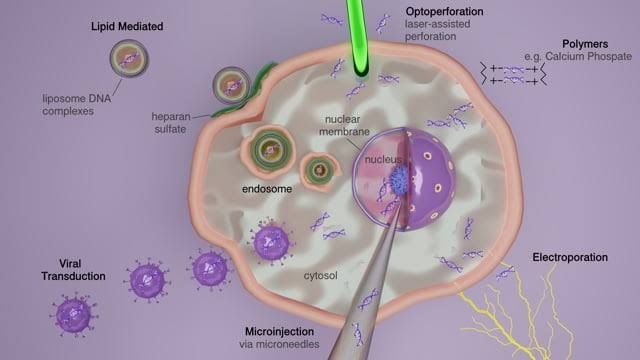
Transfection is a process used to introduce foreign nucleic acids into eukaryotic cells, allowing researchers to modify the genetic content of these cells for various applications, including gene expression studies, functional assays, and therapeutic interventions. The methods of transfection can be broadly classified into two main types: transient transfection and stable transfection.
1. Transient Transfection
Transient transfection refers to the introduction of nucleic acids into cells where the foreign DNA or RNA does not integrate into the host cell’s genome. Instead, it exists in the cell for a limited period, typically ranging from 1 to 7 days. During this time, the introduced genetic material can be expressed and produce proteins; however, it will eventually be degraded or diluted out during cell division.
Characteristics of Transient Transfection:
- Duration: The expression of the transgene is temporary and usually lasts from 24 hours up to several days.
- Mechanism: The introduced nucleic acid remains as an extrachromosomal element (not integrated into the genome) and is subject to degradation by cellular nucleases.
- Efficiency: High levels of protein expression can be achieved due to the high copy number of plasmid DNA present in the cells.
- Applications: Commonly used for short-term experiments such as screening assays, protein production, or functional studies where long-term expression is not required.
Transient transfection is often performed using supercoiled plasmid DNA because it has been shown to enhance uptake efficiency by cells compared to linearized DNA. Other molecules like siRNAs, miRNAs, and mRNAs can also be used in transient transfections.
2. Stable Transfection
In contrast, stable transfection involves integrating foreign DNA into the host cell’s genome or maintaining it as an episomal plasmid that replicates alongside the host genome. This allows for long-term expression of the introduced gene across multiple generations of cells.
Characteristics of Stable Transfection:
- Duration: The expression of the transgene is persistent and can last indefinitely as long as the cells are maintained under appropriate conditions.
- Mechanism: The foreign DNA integrates into the genomic DNA or exists as an episome within the nucleus.
- Efficiency: Typically results in lower levels of protein expression compared to transient transfections due to fewer copies being integrated per cell.
- Applications: Useful for generating stable cell lines that continuously express a gene of interest for long-term studies on gene function or drug development.
To achieve stable transfection, a selectable marker (such as antibiotic resistance genes) is often included in the construct. After introducing the nucleic acid into target cells, selective pressure (e.g., antibiotics) is applied to eliminate non-transfected cells. Only those that have successfully integrated or maintained the foreign DNA survive and proliferate.
In summary:
- Transient Transfection provides temporary gene expression suitable for short-term studies.
- Stable Transfection allows for permanent integration and long-term gene expression useful for creating stable cell lines.
The choice between transient and stable transfection depends on experimental goals regarding duration and level of gene expression required.







